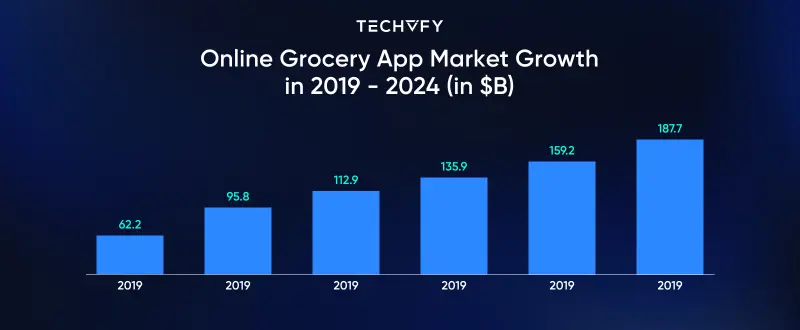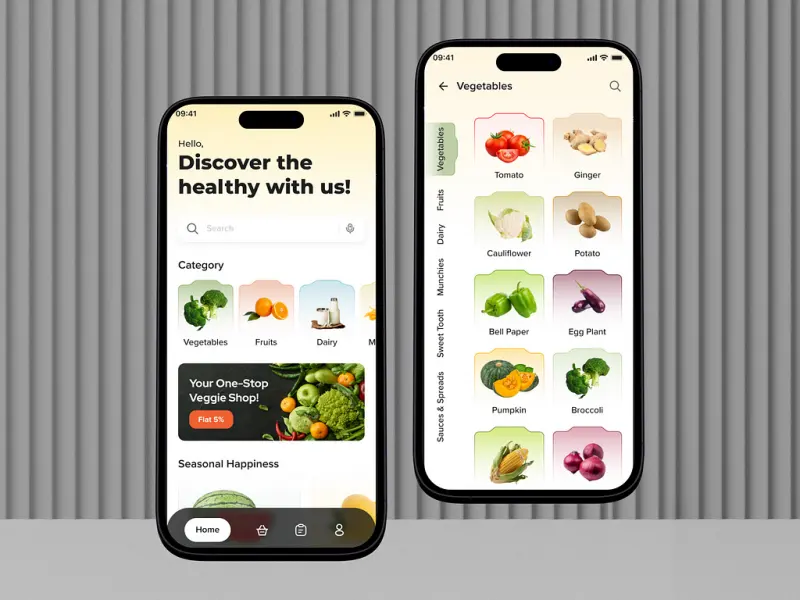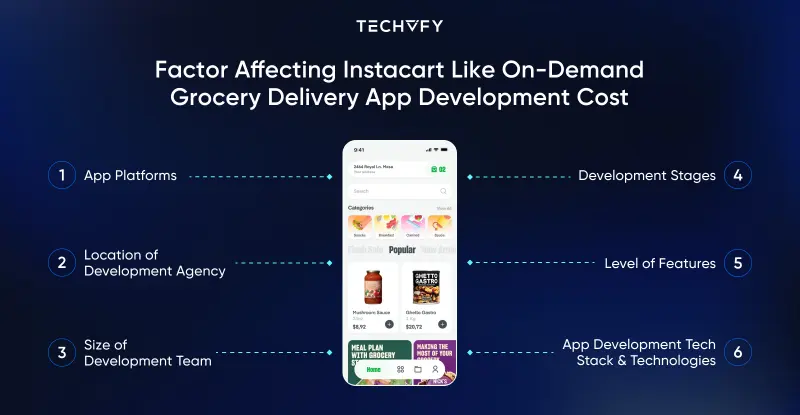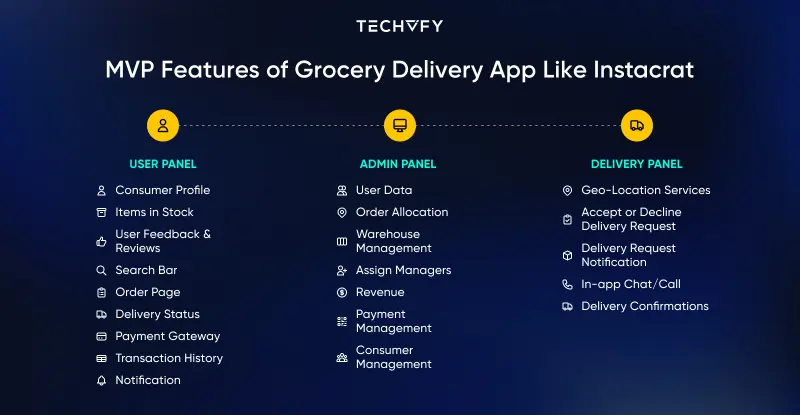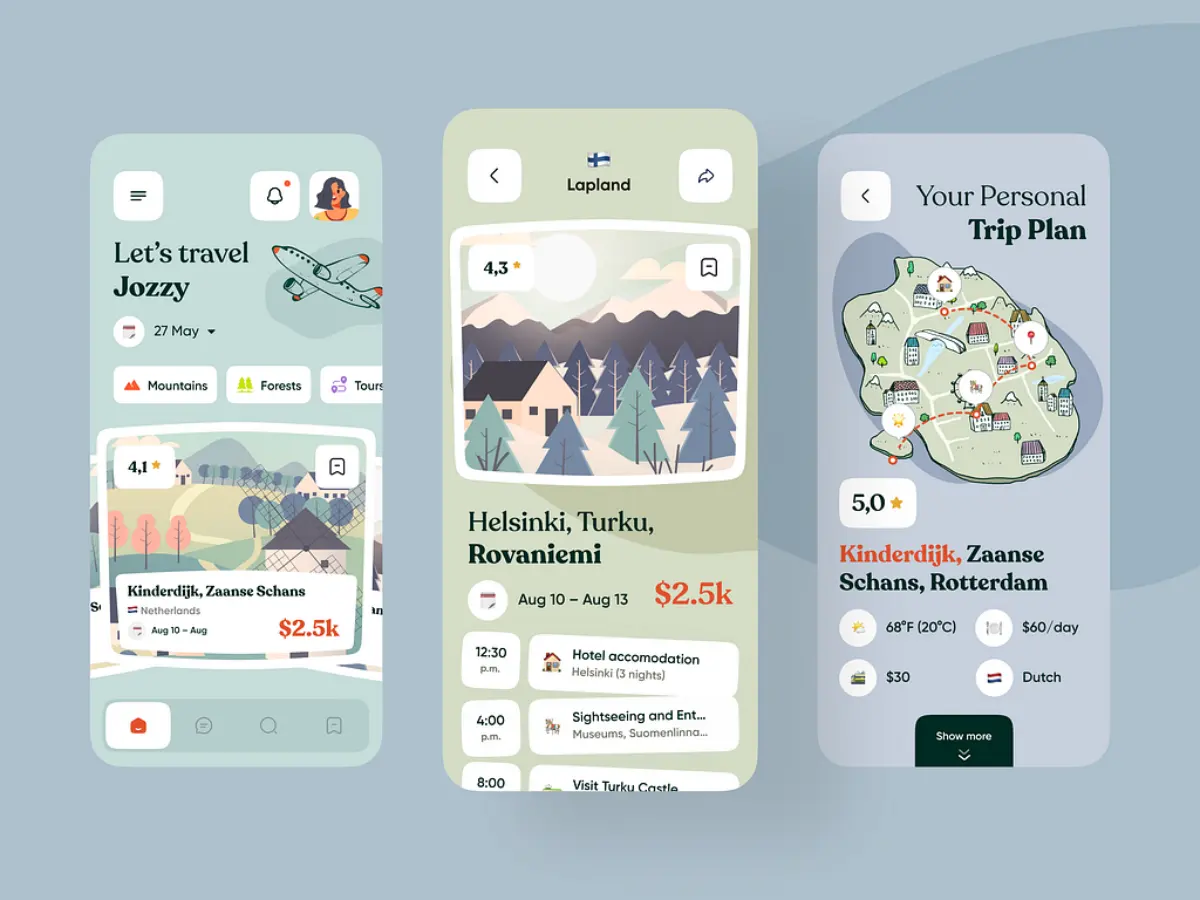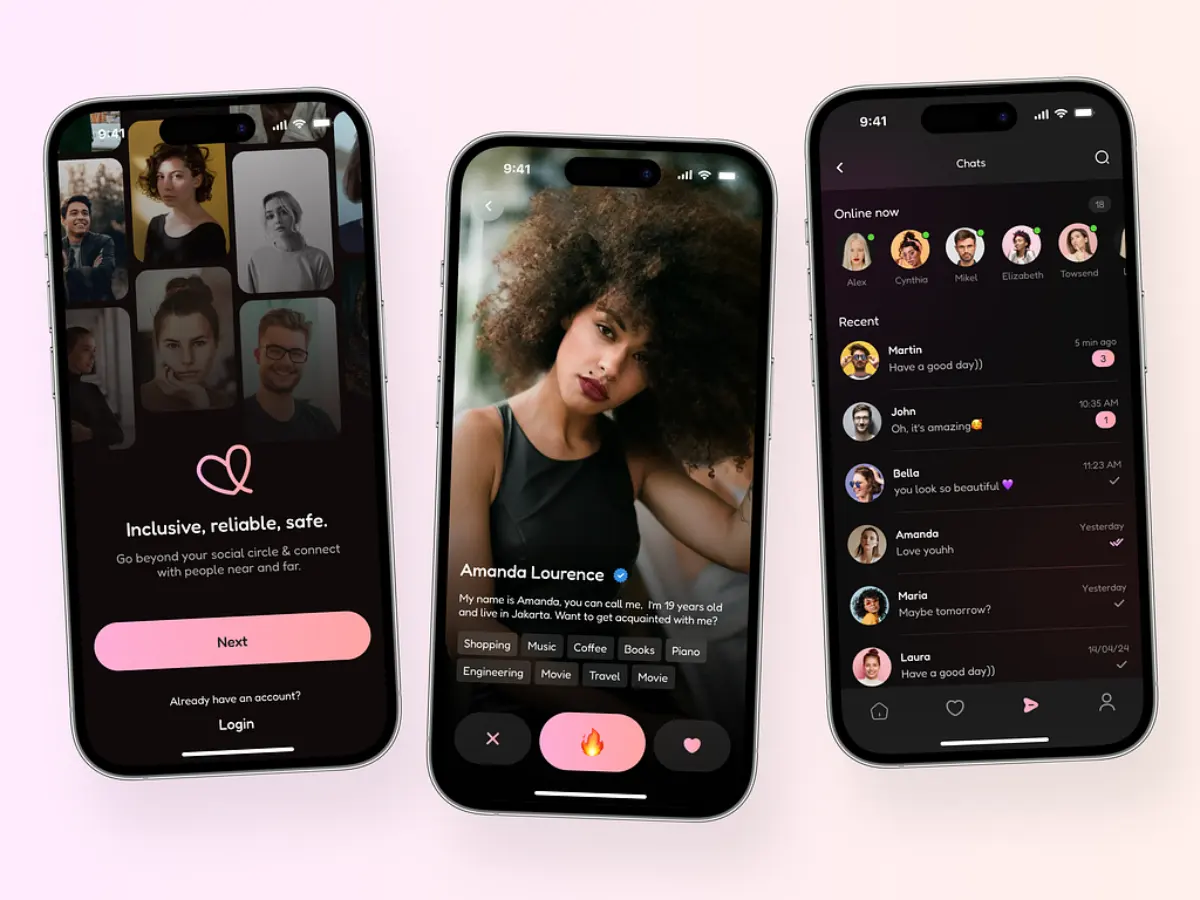What Influences Grocery App Development Cost? A Detailed Breakdown
- TECHVIFY Team
- 0 Comments
The online grocery industry has jumped into the digital world, following the steps of many other mobile app sectors. Our everyday routines have become a lot easier thanks to these apps—whether it’s ordering food or getting a ride, it’s all just a few taps away on your phone.
The importance of grocery delivery services like Big Basket became crystal clear during the pandemic. In fact, services like Instacart in the US saw a huge spike in downloads—up by an impressive 218% in March 2020 alone. So, if you’ve been thinking about building your own grocery app, now’s a great time to get started.
But before you dive in, there are two big questions to answer: How do you actually create a grocery app? And what will it cost to build one?
We’ve got the second question covered for you. Stick around as we break down grocery app development cost, along with the key features that can impact that cost. Let’s get into it!
How Grocery Delivery Apps Are Shaping the Future of Retail
Advances in technology, shifting customer expectations, and changing market trends are creating big opportunities for grocery retailers to stay ahead by embracing grocery app development. These modern, on-demand solutions are transforming how grocery businesses operate, and the numbers back this up.
For example, the grocery delivery market is projected to hit a whopping $627.30 billion in 2023. Plus, the number of users in this space is expected to grow to 2,034.8 million by 2027. Revenue? It’s set to soar to $1,003 billion by 2027, with an annual growth rate (CAGR) of 16.85%.
According to a Technavio report, the online grocery delivery market is expected to grow by $652.45 billion at a CAGR of 19.43% between 2022 and 2027. These stats show that grocery apps are not just a trend—they’re shaping the future of retail.
More App Development Insights:
Benefits of On-Demand Grocery Apps That Make Them So Popular
On-demand grocery apps offer plenty of benefits for both customers and business owners. Let’s take a closer look at why they’ve become so popular.
For Customers
Time-Saving
In today’s fast-paced world, time is one of the most valuable commodities. Many people, especially millennials, turn to technology to make their lives easier and more convenient. On-demand grocery apps save users a lot of time—especially with the rise of 10-minute delivery services—which means they can spend less time shopping and more time doing what matters most to them.
Convenient
With an on-demand grocery app, users can place an order from anywhere, anytime, as long as they have a smartphone and an internet connection. It’s easy, hassle-free, and fits right into their busy schedules. Plus, having groceries delivered right to their doorstep frees up more time for other productive activities.
Prevents Overspending
One of the challenges of in-store shopping is the temptation to buy things that weren’t on your list. With a grocery delivery app, users can avoid impulse buys and stick to exactly what they need, helping them stay on budget.
Saves Money
On-demand grocery apps often feature exciting promotions, discounts, and loyalty programs that help users save money. Whether it’s a festival season offer or a special coupon, these deals make users more likely to order regularly and enjoy significant savings.
Quick and Secure Payments
Grocery apps offer safe and easy payment options. Customers have the option to select from a range of digital payment methods, including credit cards, debit cards, UPI, and more. Many apps also allow cash-on-delivery, giving users the flexibility to pay online or offline when their groceries arrive.
Grocery delivery app development cost
For Grocery Businesses
Boost Sales by Bridging the Gap Between Offline and Online Stores
If you already have a local grocery store, a mobile application can expand your customer base by bringing your store online. With the help of mobility solutions, you can automate business operations, keep up with trends, and stay ahead of the competition. Plus, your local customers are more likely to trust and connect with you when they can find you online.
Go Mobile Without Breaking the Bank
For startups looking to enter the online grocery market, developing an on-demand grocery app is a cost-effective solution. You can start with an MVP (Minimum Viable Product) version of your app, which focuses on basic features, to keep development costs low. This allows entrepreneurs to build a mobile app without overspending, while also reducing operational costs.
Alternatively, you can opt for an Instacart-like clone app, which is much more affordable than building a custom grocery app from scratch. Even if you later decide to add all the features offered by popular apps, the total investment will still be lower compared to building a custom app with those same features from the beginning.
Make Grocery Delivery a Time-Saving Process
Managing a large user base for grocery delivery requires significant time and resources. Whether you choose a custom solution or a clone app, on-demand grocery apps help streamline the process, making it easier to handle customer orders and deliveries efficiently.
Expand Your Customer Base
When you’re operating a physical grocery store, your customer reach is limited to word-of-mouth and personal relationships. But with an on-demand app, your services can reach a much larger audience, with no geographical limitations. This means you can attract new customers from all over, helping your business grow.
Enhance Your Marketing Efforts
Developing an on-demand grocery app not only expands your customer base, but also opens up new marketing opportunities. Digital channels allow you to promote your offerings to an international audience at a much lower cost than traditional marketing. Plus, online platforms give you the flexibility To focus on particular customer groups and gather meaningful insights into how they interact.
Have a Project Idea in Mind?
Get in touch with experts for a free consultation. We’ll help you decide on next steps, explain how the development process is organized, and provide you with a free project estimate.
Factors That Affect Grocery App Development Cost
Factors affect grocery app development cost
Factor #1 – Size of the Development Team
The size of your development team has a significant impact on the cost of building an on-demand grocery delivery app. To make an effective app, you’ll need a well-rounded team that includes QA testers, project managers, team leads, app developers, and app designers.
A dedicated team of highly skilled developers is key to creating a successful grocery delivery app. These experts should have a solid understanding of grocery app standards and enough experience to deliver a high-quality product.
- App Developers: This includes iOS developers, Android developers, and back-end developers.
- App Designers: UX/UI designers and graphic designers with experience in grocery delivery apps.
- Project Manager: A manager with both technical and leadership skills to ensure smooth project execution.
- App Testers: QA experts who specialize in testing and bug tracking.
Factor #2 – Location of the Development Agency
The location of your development team plays a big role in your overall costs. Developers from different countries charge different rates, and if you’re outsourcing, you’ll find that prices can vary quite a bit.
Here’s what you can expect to pay for grocery app developers in Vietnam:
- Vietnam: $20 to $50/hour
For comparison, here’s a look at other regions:
- Eastern Europe: $79 to $140/hour
- United States: $50 to $240/hour
As you can see, Vietnam offers a more affordable option while still providing skilled developers.
Factor #3 – App Platforms
If you’re building your app for just one platform, such as iOS or Android, your costs will be lower. However, building for multiple platforms will cost more. iOS and Android are the leading platforms in the mobile market.
While there are more Android users globally, you’ll need to choose the platform that best suits your audience. Another option is to choose cross-platform development to reach users on both platforms.
On average, developing an app like Instacart on a single platform (either Android or iOS) could cost between $15,000 and $30,000.
Factor #4 – App Development Tech Stack & Tools
The tech stack you choose for your app will also influence the overall development cost. Different businesses use different tools based on their team’s expertise and budget. Here are some of the common tech stacks used to build an on-demand grocery app like Instacart:
- Programming Languages: JavaScript, Java, or Kotlin for front-end and back-end features.
- Front-End Frameworks: React Native, Angular, or Vue.js.
- Back-End Frameworks: Node.js, Ruby on Rails, or PHP.
- Database Management: MySQL, MongoDB, or PostgreSQL.
- Payment Gateways: Stripe, PayPal, or Braintree.
- Location Services: Google Maps or Mapbox.
- Push Notifications: Firebase Cloud Messaging or Apple Push Notification Service.
Factor #5 – Development Stages
Building an app takes time, and each stage of development involves specific professionals to make sure everything runs smoothly. From brainstorming ideas to testing the final product, each step requires careful planning, which can increase development costs.
Here’s a breakdown of the estimated time and costs for each stage if you’re outsourcing to Vietnam:
| Development Stage | Estimated Time | Estimated Cost (Vietnam) |
|---|---|---|
| Project Planning | 2-4 weeks | $2,000 – $4,000 |
| UI/UX Design | 4-6 weeks | $4,000 – $8,000 |
| Front-End Development | 8-12 weeks | $8,000 – $15,000 |
| Back-End Development | 12-16 weeks | $10,000 – $18,000 |
| Quality Assurance Testing | 4-6 weeks | $4,000 – $8,000 |
| Deployment & Maintenance | Ongoing | $2,000 – $5,000 |
| Total Estimation | 30-44 weeks | $15,000 – $50,000 |
Factor #6 – Level of Features
The features and functionality you choose will have the most significant impact on the cost of your app. It’s important to include the essential features needed for a grocery delivery app, but adding more advanced options will increase your expenses. So, you’ll need to strike a balance—make sure you cover the basics while being mindful of the cost of any extra features you want to add.
Grocery App Development Cost Detail Breakdown
When creating a grocery delivery app, the process typically starts with gathering requirements and selecting the best technology stack to meet your project’s objectives. The cost of development can fluctuate based on a number of factors, including the platform you choose, the development region, and the complexity of the app’s features.
Below is an overview of the factors that can affect the cost of developing a grocery app:
| Cost Component | Estimated Hours / Cost | Vietnam | USA/Europe |
|---|---|---|---|
| App Development | 1900 – 2400 hrs | $37,800 – $125,500 | $94,500 – $425,200 |
| App Store Submission | One-time fees | $25 (Google) + $99/year (Apple) | $25 (Google) + $99/year (Apple) |
| Marketing Budget | Initial promotion | $5,000 – $20,000 | $5,000 – $20,000 |
| App Maintenance (1 Year) | 1/5th of dev. cost | $7,560 – $25,100 | $18,900 – $85,040 |
| Reusing Existing Code | ~20-30% savings on dev. costs | (-$7,560 to -$37,650) | (-$18,900 to -$127,560) |
| Total Estimated Cost (1 Year) | Development + Maintenance + Marketing | $42,825 – $170,700 | $117,525 – $530,339 |
Ways to Optimize Grocery App Development Costs
As you’ve gathered from the previous section, developing a grocery delivery app requires a significant amount of time, money, and effort. That’s why it’s important to find ways to optimize the costs and still create a high-quality app. Below are some effective methods you can use to reduce your grocery app development costs without compromising on the app’s quality.
Prioritize Essential Features
You can streamline your grocery app development costs by focusing on a simple app design that includes only the most necessary features and functionality. Fewer features not only help reduce the development time and costs but also make the app easier for users to understand and navigate. This, in turn, can lead to higher customer engagement. Additionally, you can start by developing an MVP (Minimum Viable Product) focuses on the essential features. This approach helps you gather important feedback from users that can guide future development. This approach helps you avoid wasting time, resources, and money on unnecessary features that users may not even need.
Recommended features
Initially, you can opt for a basic and uncomplicated design along with essential features, which will help lower your development costs. As your app gains traction and you receive feedback from users, you can gradually add more advanced features to enhance the app’s functionality.
Click Here to learn about various features that should be included in your app for customers, vendors, and admin.
Choose a Scalable Technology Stack
Selecting the appropriate technology stack is vital because it plays a critical role in determining the app’s design, functionality, features, and user interface. A scalable technology stack can help you optimize development costs in the long run. For instance, if you want to develop an app for both Android and iOS, opting for a cross-platform development approach is a cost-effective solution. Cross-platform development enables you to create an app for multiple platforms with one shared codebase, which helps minimize the cost of developing separate apps for each platform.
By selecting the right technology stack, you not only ensure that your app is built efficiently, but you also save on maintenance and future development costs as your app grows and evolves.
Want to get a detailed study on the scalable technology stack for your grocery app development? Click Here to know more!
Leverage Pre-Built Solutions
Developing an app from the ground up is both time-intensive and labor-intensive process, which can significantly increase your overall development costs. To reduce these expenses, you can leverage pre-built templates that many grocery app development companies offer. These templates come with pre-designed features that are both attractive and cost-effective, allowing you to get your app up and running faster and at a lower cost.
Additionally, you can take advantage of third-party libraries to further cut down on development time and costs. For example, instead of building custom solutions for payments, navigation, messaging, or customer support, you can integrate third-party services that are already available and reliable. This approach allows you to save both time and money while still delivering a fully functional app to your users.
Consider a Phased Development Approach
When building an app, rolling out every feature in the initial launch is not always necessary. A phased development approach allows you to release your app with the essential features first and then gradually add more features over time. This approach helps you reduce the initial development costs and gives you the flexibility to spread out your investment.
It also provides the added benefit of keeping customers engaged with regular updates and new features. Rather than overwhelming users with too many features at once, you can introduce new functionalities step by step, allowing them to familiarize themselves with the core app before exploring more advanced options in future updates.
Conclusion
The grocery delivery industry is booming, and it’s clear that having a well-built app is no longer just an option—it’s a necessity for businesses looking to thrive in this modern, on-demand economy. As consumer habits shift towards online shopping, investing in a grocery delivery app is a smart way to future-proof your business and tap into this growing market.
Get a free consultation with our experts today. When you work with TECHVIFY, you’ll gain access to top-tier development talent, ensuring your app performs seamlessly and scales with your business. We don’t just build apps—we craft customized solutions tailored specifically to your needs, helping you maximize your investment with cost-effective strategies like reusable code and cross-platform development. Plus, our partnership doesn’t end at launch. We provide ongoing support to keep your app functioning efficiently and equipped with the most recent updates.
TECHVIFY – Global AI & Software Solutions Company
For MVPs and Market Leaders: TECHVIFY prioritizes results, not just deliverables. Reduce time to market & see ROI early with high-performing Teams & Software Solutions.
- Email: [email protected]
- Phone: (+84)24.77762.666




